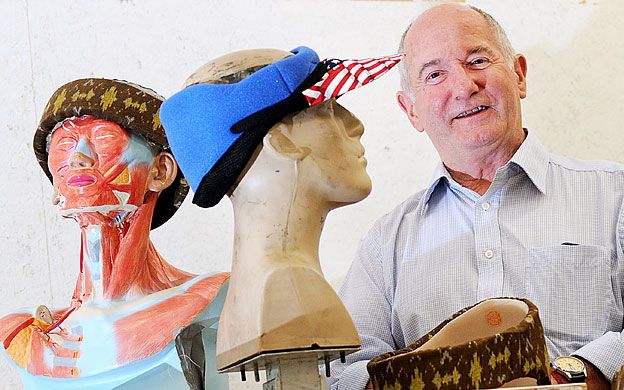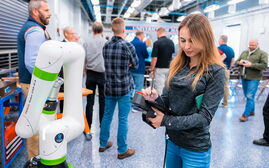Winthrop company aims to prevent brain injury, in style
 PHOTo / Amber Waterman
James Ferguson, founder of Alba-Technic in Winthrop, is working to add a removable visor to his helmet so the wearer can use it comfortably outdoors as well as indoors.
PHOTo / Amber Waterman
James Ferguson, founder of Alba-Technic in Winthrop, is working to add a removable visor to his helmet so the wearer can use it comfortably outdoors as well as indoors.
James Ferguson expected to turn heads when he took his colleague, who was wearing a prototype helmet aimed at cushioning falls and preventing traumatic brain injury, to Margaritas Mexican Restaurant in Augusta.
“No one looked at us,” he laughed when retelling the story. But that's exactly the point of the new helmet, which looks more like a fabric-covered headband. He claims the helmet, called the Smarty, is as effective as the bulkier competition now on the market.
“But people will wear it,” he adds, saying the company's “fashionable” headgear de-stigmatizes wearing a helmet in public.
The company even has a YouTube video with a patient suffering from a seizure disorder who tried it saying so.
“People aren't willing to wear a helmet that covers the whole head,” says Ferguson of the compliance trial conducted by his friend, who also is a professor of medicine at the University of California at Los Angeles. Competitive models cover the entire head, but Ferguson says most injuries occur around the sides of the head rather than the top.
Ferguson is president of Alba-Technic LLC, a development-stage company in Winthrop that has tested its product for shock absorption and energy dissipation, and is getting ready to commercialize it. So far, the company has pulled in more than $1.13 million in the form of two federal Small Business Innovation Research grants and five seed grants from the Maine Technology Institute. The money is chasing several potentially lucrative markets, the first being fall-prone seniors. And in the future, an even thinner version of the product under development now could be worn as a liner inside sports or motorcycle helmets to offer added impact absorption protection. Motorcycle helmets, for example, are designed to prevent a skull fracture, but don't necessarily prevent or reduce damage to brain tissue, he says.
In referencing multiple medical articles, Ferguson notes that 20%-30% of seniors fear falling, and with good reason. Some 35%-40% of people aged 65 and older fall each year, and those who do are two to three times more likely to fall again. Upwards of 20% of those falls result in serious injuries.
At least 1.7 million traumatic brain injuries occur annually, resulting in 52,000 deaths and 275,000 hospitalizations, according to the U.S. Centers for Disease Control and Prevention. The number of people with traumatic brain injuries (TBI) who are not seen in a hospital or emergency department or who receive no care is currently unknown, and that's a real problem, says Ferguson.
“If you're hit on one side of the brain, you can be injured on the other side,” he says of the transference of energy from the initial impact location. “Lots of injuries go undiagnosed. You should never shake it off.”
TBI is a contributing factor to 30.5% of all injury-related deaths in the United States. Adults aged 75 and older have the highest rates of TBI-related hospitalization and death, though other susceptible age groups are children up to age 4 and adolescents aged 15-19. Direct medical costs and indirect costs such as lost productivity of TBI totaled some $76.5 billion in the United States in 2000, according to the CDCP.
Alba-Technic plans to sell to patients, medical facilities and to senior care centers hoping to avoid the costly lawsuits that might result after falls. It does not plan to pursue the pediatric market (see sidebar). The company is named for the old moniker for Scotland, Alba, and the advanced technology sense the word Technic brings to mind in Europe. Ferguson, who hails from Scotland, started the company in 2005 with his wife, Helen Loos, who is CEO.
Rooted in the head-butt
Ferguson, a design engineer who said he formerly performed energy management work, first designed a cushioning headband for the youth soccer team he was coaching on Cape Elizabeth.
“The kids were hesitant to head-butt the soccer ball, so I made them a 'Clash' band so they wouldn't sting their heads,” he says.
A visit from a friend from California, Dr. Steven Castle, who is the geriatric physician who conducted the consumer preferences clinical trial for Alba-Technic's helmet and also is clinical director of geriatrics at the VA Greater Los Angeles, prompted Ferguson to try to broaden the use of the Clash band.
“He said his sons were using it for soccer, but I said 'I know exactly what that's for.' We don't have a product and there's a need for this in older adults. It could become like a seat belt,” says Castle.
Castle also is the friend who wore the current prototype of the helmet, which has a detachable visor, at the Mexican restaurant. “The key we found is that patients are going to wear it,” he says. “I think this will make a difference. It could become more of a mainstream product.” Of the dozen patients he tested, half wearing the Smarty and half a competitive helmet, 88% wore the Smarty for 12 hours a day on average, whereas they wouldn't wear the other helmet in public. “They saw the competition as not for them, saying 'If I am that bad off, I wouldn't be going out.'”
Castle adds that sizing is a key feature in that the helmet must accommodate use of the telephone, as well as hearing aids and glasses. He also says the liner is too warm, so another material that can wick away moisture is needed.
While Alba-Technic only has two employees, Ferguson and his wife, it has a team of collaborators who include Castle, Vince Caccese, professor at the University of Maine, where the device was tested for impact in the Advanced Biomechanics Laboratory for Injury Reduction and Rehabilitation; Grace Griensback, adjunct professor at the UCLA Brain Injury Research Center; John Lloyd, director of the Tampa Veterans Affairs Research Center of Excellence; and Brian Schulz, an assistant director at the same Tampa research center.
The company also is in the process of adding two management people who are experienced with medical devices to help get the product, when it is commercialized, into key accounts.
Honeycomb helps absorb impacts
The Smarty helmet uses a two-layer design. One layer is a flexible honeycomb thermal plastic material that can absorb energy in three directions, and the other is a stiffer dilatant material that dissipates energy. The result is an 84% decrease in head injuries in impact experiments on crash test dummies at independent laboratories, and about a 62% reduction in impact energy, Ferguson says. With a fashionable fabric covering that will be available in different colors, the prototype Smarty weighs about 7 ounces. Three sizes, small, medium and large, will be available.
Getting the correct matrix and size of honeycombs was no small task.
“We did thousands of experiments on different honeycomb structures,” Ferguson says. He has patents on the two-layer structure in both the United States and Europe, and a derivative U.S. patent on using the material in sports applications. The patent in Canada is pending.
Testing for different types of falls also proved challenging.
“The key issue we had is that we didn't know the energy input experience of the different types of falls,” Ferguson explains. Parkinson's patients tend to hold out their arms sideways to keep from falling forward, which happens in about 35% of falls. But 35% of the time they tend to fall backward onto the very thin part of the skull above the neck, breaking it and resulting in 51% fatalities, he says.
Caccese from the University of Maine agrees with Castle that work still needs to be done on the helmet lining, as well as the helmet's impact resistance and automated manufacturing. The impact resistance may be handled by thickening one of the two materials in the helmet, but without compromising its asthetics, he says, adding that there's no use designing something that no one will buy or wear.
The company is experimenting with molds to make the helmet and with ways to get it into production volumes.
“We need to look at how to go from pilot manufacturing to an automated line,” Ferguson says. He is working with the University of Maine and another unspecified manufacturer to help with the task.
After production is settled, Ferguson says he likely will seek more funding from a commercial partner with a medical device marketing network that also can market the helmet and help get it through the U.S. Food and Drug Administration approval as a Class 1 medical device, which is subject to the least control by the FDA. He says there's a good possibility the company will pick a manufacturer for the Smarty in Maine.
Lots of potential
Alba-Technic plans to sell the Smarty for around the same price as competitive models, or about $250. Ferguson says Medicare pays up to $166 for such protective headgear, so the patient must pay around $100.
He sees many users of the helmet, including people recovering from a concussion who are prone to falling, people on blood thinners who could bleed out if they hit their head hard, and the elderly who fall because there isn't enough light, they trip over a rug, their knee goes out on a step, they have hip surgery, they are generally frail, or they have Parkinson's. Other potential applications he is not currently pursuing include horseback riding saddles for the disabled and liners for Kevlar vests to help absorb impacts.
The company has no outside investors or debt, says Ferguson. Before the first SBIR grant was awarded, the National Institutes of Health, which was a funder of the grant, commissioned a study by Foresight Science & Technology Inc., a technology commercialization consultancy in Providence, R.I., to look at the commercialization potential of the Smarty. Foresight estimated the sales potential for the company in the first year at 5,000 helmets or $750,000 if the product sells for $150 per unit and 70,000 units or $10.5 million in five years, with $20 million over the first five years of sales, Ferguson says. The revenue will be higher if the helmet is priced at $250.
Read more
Winthrop company wins $250,000 grant for head injury-protection material
Maine tech developments receive $55K from MTI













Comments